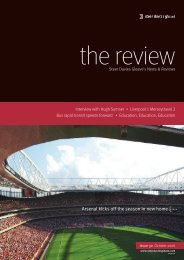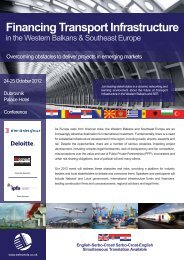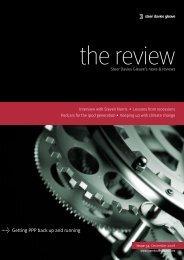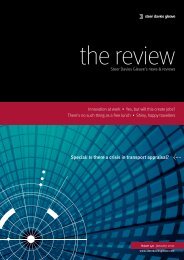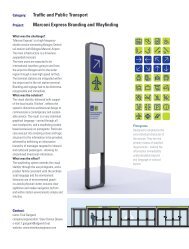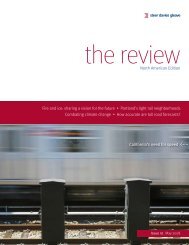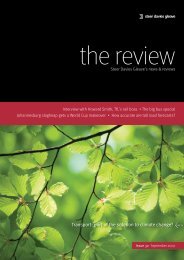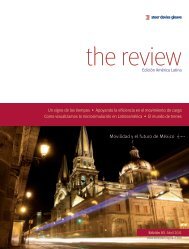Making the cut: UK spending review special - Steer Davies Gleave
Making the cut: UK spending review special - Steer Davies Gleave
Making the cut: UK spending review special - Steer Davies Gleave
Create successful ePaper yourself
Turn your PDF publications into a flip-book with our unique Google optimized e-Paper software.
policy and planning cycling<br />
Pedal power<br />
As <strong>the</strong> cycling culture continues to grow in <strong>the</strong> <strong>UK</strong>, we offer ways<br />
to help authorities instil and improve cycling in <strong>the</strong>ir areas.<br />
By Pete Zanzottera<br />
It’s not just <strong>the</strong> recent<br />
launch of London’s new<br />
cycle hire scheme; <strong>the</strong><br />
momentum behind<br />
cycling has steadily been<br />
building over <strong>the</strong> last<br />
several years in <strong>the</strong> <strong>UK</strong>.<br />
Journeys by cycle in <strong>the</strong><br />
capital have doubled in <strong>the</strong> last decade.<br />
The Cycling Town initiative has increased<br />
cycling in <strong>the</strong> participating towns by 27%<br />
on average in just three years. With political<br />
backers and cycling enthusiasts such as<br />
Johnson, Villiers, Baker and Mr Cameron<br />
himself, cycling remains high on <strong>the</strong><br />
government’s agenda. And as a relatively<br />
low-cost means to achieve transport<br />
objectives, now is a real opportunity to<br />
push <strong>the</strong> bike out even fur<strong>the</strong>r. Here are<br />
a few ways <strong>Steer</strong> <strong>Davies</strong> <strong>Gleave</strong> can help<br />
develop cycling strategies for local areas:<br />
Getting audited<br />
Many cities and towns have some routes<br />
but few have a well-connected and<br />
differentiated network that is coherent and<br />
easy to understand. Using cycle-based<br />
video analysis, connected to GPS and<br />
o<strong>the</strong>r sensors, we can conduct extensive<br />
and detailed audits on cycle networks.<br />
6<br />
For example, in Potters Bar, we have<br />
used <strong>the</strong>se methods to capture all of <strong>the</strong><br />
roads and potential routes to classify <strong>the</strong><br />
existing network according to <strong>the</strong> three<br />
Bikeability training levels (based on<br />
cyclists’ experience and confidence):<br />
t level 1 – off-road and traffic-free routes<br />
t level 2 – light-trafficked roads<br />
and residential areas<br />
t level 3 – busier roads with<br />
higher levels of traffic<br />
Improving networks<br />
Working out suggested improvements<br />
to <strong>the</strong> networks and prioritising <strong>the</strong>m is<br />
something that we understand completely.<br />
In some cases this may involve developing<br />
a full business case and generating cost<br />
benefit analysis figures. Generally <strong>the</strong> costs<br />
to build a network are relatively easy to<br />
calculate and it is possible to put forward<br />
a set of improvements that could be built<br />
quickly. Calculating benefits for cycle<br />
routes is more complex and very sensitive<br />
to <strong>the</strong> number of existing cyclists and <strong>the</strong><br />
estimate of new cyclists. Our work focuses<br />
on improving <strong>the</strong> connectivity of a cycle<br />
network and providing ‘missing links’ that<br />
will help to encourage more people to cycle.<br />
Mapping it out<br />
Featured in <strong>the</strong> last issue of The Review,<br />
our new Cycling Potential Index (CPI) tool<br />
visually displays an area’s underlying<br />
attractiveness for cycling in terms of<br />
topography, demographics and potential<br />
usage. The results can be overlaid on<br />
network improvements to help judge where a<br />
cycle route or network will be most effective.<br />
Getting into <strong>the</strong>ir heads<br />
In addition, having insight into <strong>the</strong><br />
behaviour of cycling – who does it, why,<br />
where and when – is invaluable when<br />
trying to promote and encourage new<br />
cycling schemes. <strong>Steer</strong> <strong>Davies</strong> <strong>Gleave</strong> has<br />
undertaken innovative research and analysis<br />
regarding projects such as <strong>the</strong> London Cycle<br />
Hire Scheme and Cycle Superhighways.<br />
This work has particularly focused on<br />
route alignments, user profiles, potential<br />
demand and uptake of proposed work and<br />
home-end Smarter Travel measures.<br />
To find out more contact<br />
Pete Zanzottera<br />
t +44 (0) 113 389 6400<br />
e pete.zanzottera@sdgworld.net




